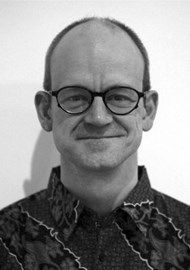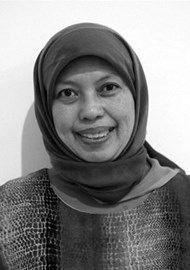In the first article of a two-part series (see Part 2 here), the authors provide an overview of this hugely successful partnership and how they overcame the challenges of COVID-19.
What began in 2008 as a connection between equals, has developed in remarkable and unforeseen ways. In 2014 we reported on the Makassar-Dundee LINK from its inception in 2008 to 2014 [1]. While much of the VISION 2020 LINKS Programme [2] focuses on the huge needs in sub-Saharan Africa, the needs of Indonesia, with its vast population of 270 million spread over 6000 inhabited islands, are also significant.
In 2014 we were grateful to take the opportunity to reflect on the effectiveness of the partnership and were surprised at the strength of feeling on both sides for the value of the ‘marriage’. Not long after this we renewed the three-year Activity Plan for the third time. What became clear was that the highest priority was teaching. Teaching in all its forms and at every level. From the micro to the macro; from practical teaching in clinical scenarios to mentorship and ‘big picture’ training in the form of organisation of the registrar / resident training programme.
During the period, there were seismic changes in the organisation of the Indonesian healthcare system. In January 2014, the President of Indonesia, Susilo Bambang Yudhoyono, launched a form of national insurance-based health care, the Badan Penyelenggara Jaminan Sosial (Social Insurance Administration Organisation) BPJS Kesehatan, which was later strengthened by Joko Widodo when he was president. All persons in employment entered the scheme. In LINK visits over the two years leading to full implementation (January 2016), we observed rapid and significant rises in the throughput of patients in outpatient and surgical services. National income tax is 15% or less for over 95% of the population and 38% live at ≤1.5 times the poverty level ($38 per capita/per month). Revenues did not keep pace with expenditure and the scheme was quickly in deficit.
In 2008 when the LINK started, healthcare expenditure per capita was $62; by 2017 it had effectively doubled to $115. As half of healthcare costs are met at the point of delivery, fees can be a major burden. Average life expectancy in Indonesia in 1980 was 59; today it is 72. The projected increase in the elderly population between 1990-2025 is 414%, the highest percentage increase of all 48 countries for which data were obtained by World Health Organization (WHO) in 1995. This equates to an increase from just under nine million elderly in 1980 to just over 29 million in 2020 [3]. These demographic pressures and healthcare reforms led to a very rapid maturing of the system and eyecare expansion was essential.
With the emphasis on teaching and training needed to build the skills of the workforce to meet the pressures on the eye healthcare system, where better to look than to ‘Train the Trainers’ and the experience in the Royal College of Ophthalmologists?
Train the Trainers
The first Train the Trainers (TTT) course was held in November 2016 in Jakarta. A formal invitation was made by Perdami, the Indonesian Ophthalmologists Association and governing body of ophthalmologists, to the Royal College of Ophthalmologists (RCOphth). This was led by Melanie Corbett, with assistance from Andrew Pyott and Rebecca Ford. Twenty-four senior ophthalmic delegates were invited and the structure of the course was closely matched to that delivered in the UK and by College of Ophthalmology of Eastern, Central and Southern Africa (COECSA). Whilst the theoretical aspects of adult learning are discussed, the real value of the course is its interactive nature. The sessions on ‘teaching practical skills’, ‘how to give feedback’ and ‘managing trainees in difficulty’ were particularly well-received.
The TTT course has now trained three cohorts, and on each occasion the involvement of local faculty increases, with more of the discourse taking place in Bahasa Indonesia rather than English. It has been exciting to see that some of those who were residents at the start of the LINK have now matured into leaders, opinion formers and mentors on the TTT.
The courses have been a good example of the way in which learning is socially constructed. The UK faculty had to adapt to the Indonesian system and culture, and the Indonesians brought new perspectives to a course that has been well established in the UK for more than a decade. There were times that the UK faculty had to challenge each other, while for the Indonesians there were a lot of new concepts, for example, the need for feedback at all levels, and the multiplicity of reasons behind a struggling trainee. Delegates challenged the UK visitors, helping them to make appropriate adaptations to the local context. At present Drs Yunita and Abrar, both alumni from a Dundee visit, are two of the instructors on the TTT programme.
The attendees must report back on innovations taken back to their individual institutions. There are examples of improvements in presentational skills, the introduction of supervisor meetings and in general a more interactive approach to learning.
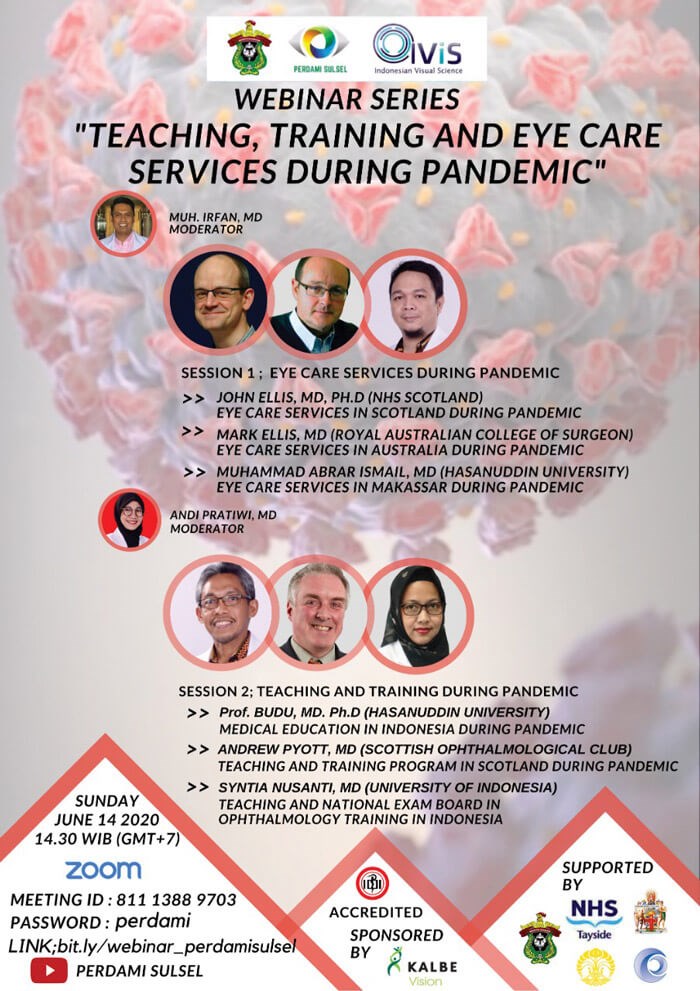
Poster promoting webinar on eyecare services
and training during the pandemic, June 2020.
Coronavirus in Indonesia
The Indonesian Ministry of Health reports that the country has experienced just under 42,000 deaths, has 113,570 ongoing cases and 1,391,000 recovered (a recovery rate of 82%; above the international average) [4]. Throughout 2020 the nation steadily rose towards WHO-expected targets for recovery. Indonesia, divided into 514 administrative regions split by risk into four tiers, was managed in ways now familiar to most national healthcare systems. In South Sulawesi the cumulative case load in early 2021 was 347 per 100,000. Reduced elective ophthalmic work was reported in all centres, being about 60% reduced in Makassar.
One of the negative effects of COVID-19 has been disruption to travel and the interchange of ideas and learning that have been the keystone of the LINK between Makassar and Dundee. All of this was paused in 2020, but the strength of the Makassar-Dundee LINK is in the mutual trust and respect and relationships forged and developed over time. Makassar has found innovative ways to progress the LINK.
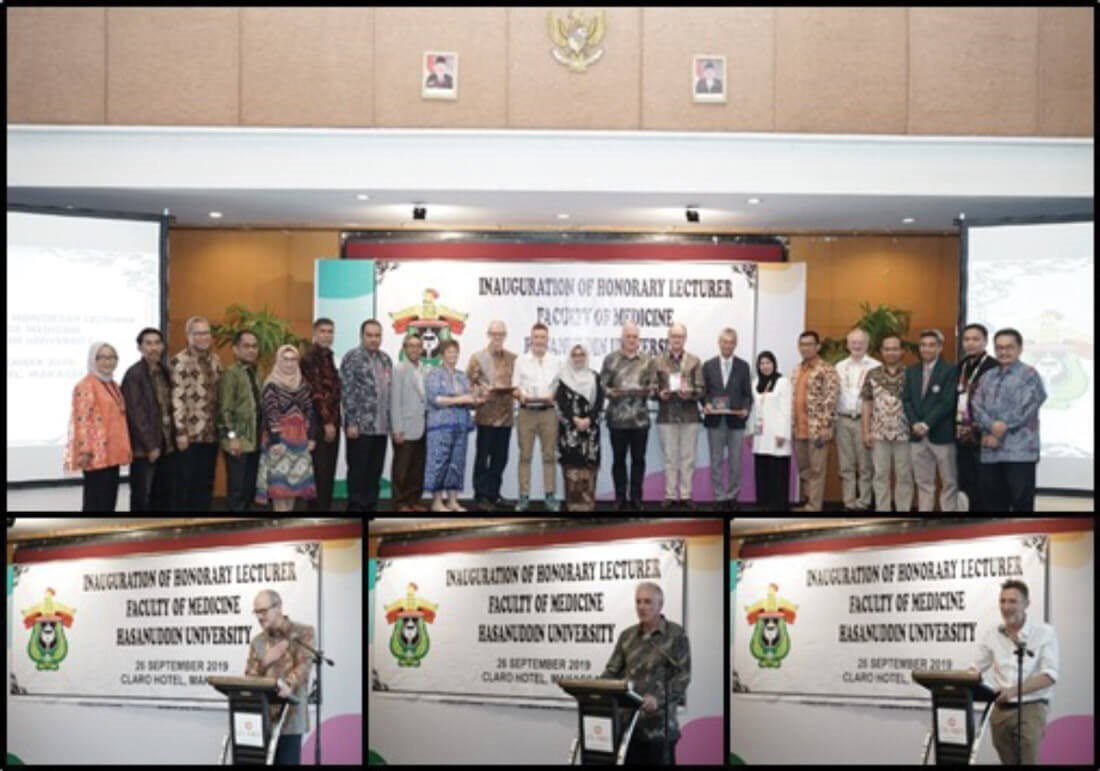
Inauguration of Honorary Lecturers by President of Hasanuddin University, Makassar, 2019.
Indonesian Professional Postgraduate Exams
Manpower development is a major issue for Indonesia, and currently there is only one ophthalmologist per two million population (over half of these being employed on Java). The training programme is relatively short, at four years, but there is a real desire to improve standards and several Indonesians have attended RCOphth exams in the UK and Singapore as observers. COVID-19 has severely impacted training and examinations throughout the world, but Indonesia is characterised by tech-savvy ‘early adopters’ who never shy away from innovation, and they have risen to the occasion.
In June 2020 a webinar for over a thousand delegates was organised and moderated by Dr Muh Irfan and Dr Andi Pratiwi, two doctors who had benefited from a visit to Dundee. There were contributions from Australia and the UK, but the Indonesian presentations showed that they were exceeding developments elsewhere for online examinations. This has been primarily led by Dr Syntia Nusanti from the National Exam Board.
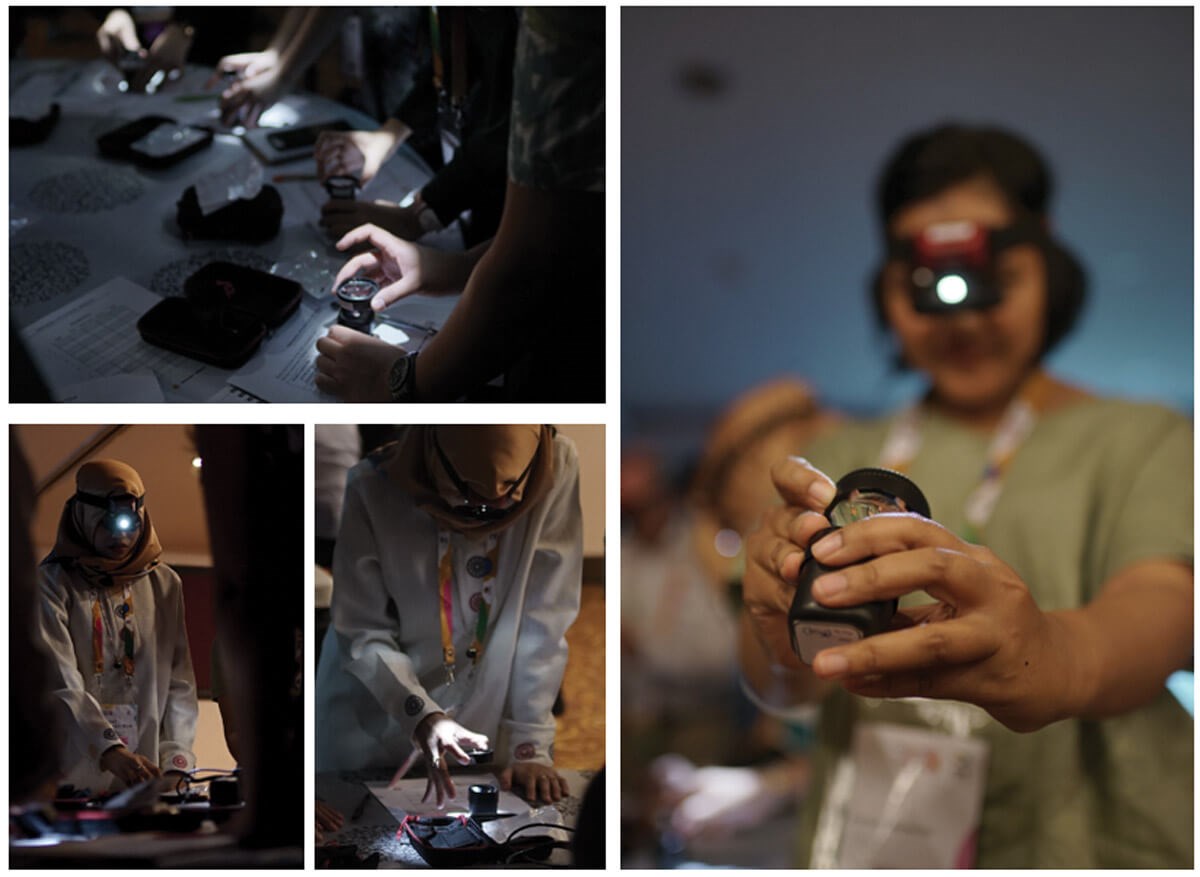
Delegates using the arclight BIO with SIM eyes at the hands-on training session, Perdami, Makassar 2019.
Paediatric ophthalmology
Consistent throughout the LINK has been the priority given to paediatric eyecare. In 2019, members of the Dundee LINK, along with Professor Brian Fleck and Dr Mike Burdon, then President of the RCOphth, were invited to be keynote speakers at the 44th Annual Scientific Meeting of Perdami, held in Makassar. The Scottish LINK partners were honoured with Senior Lectureships from Hasanuddin University.
Dr Andrew Blaikie and Professor Fleck conducted the world’s first hands-on retinopathy of prematurity (ROP) training using 20 low-cost binocular indirect ophthalmoscopes (BIO) and ROP SIM eyes developed by the Global Health Team at the University of St Andrews [5,6] with funding from the Global Challenges Research Fund and the Ulverscroft Foundation.
The simplified BIO is an extension of the frugal design philosophy used to create the Arclight direct ophthalmoscope [5]. The SIM eyes uniquely use a sinusoidal projection method to turn flat 2D images of ROP into ‘gores’ which are then cut out and folded into hemi-spherical fundi. These are then placed in the SIM eye box. When examined with the BIO, they display the full range of potential ROP and ‘plus disease’ findings needed to gain an understanding of whether to review, refer or discharge.
The fundus images are reproduced using standard home or office printers and paper, facilitating access to low-cost yet high-fidelity ROP training and assessment tools.
Most of the participants had very little previous experience with the use of BIOs and in the screening of ROP. However, there was a clear desire to pursue additional training, with a consistent increase in their confidence in identifying clinical signs of ROP during the workshop. The knowledge of when to refer and when to treat, as well as which babies to screen, was improved and a solid base for future workshops was laid down. Although the evidence of whether these workshops can improve the ability to identify specific clinical signs is still inconclusive, results are promising. Likewise, the simulation eyes were readily accepted by the participants as a simple yet effective tool for learning.
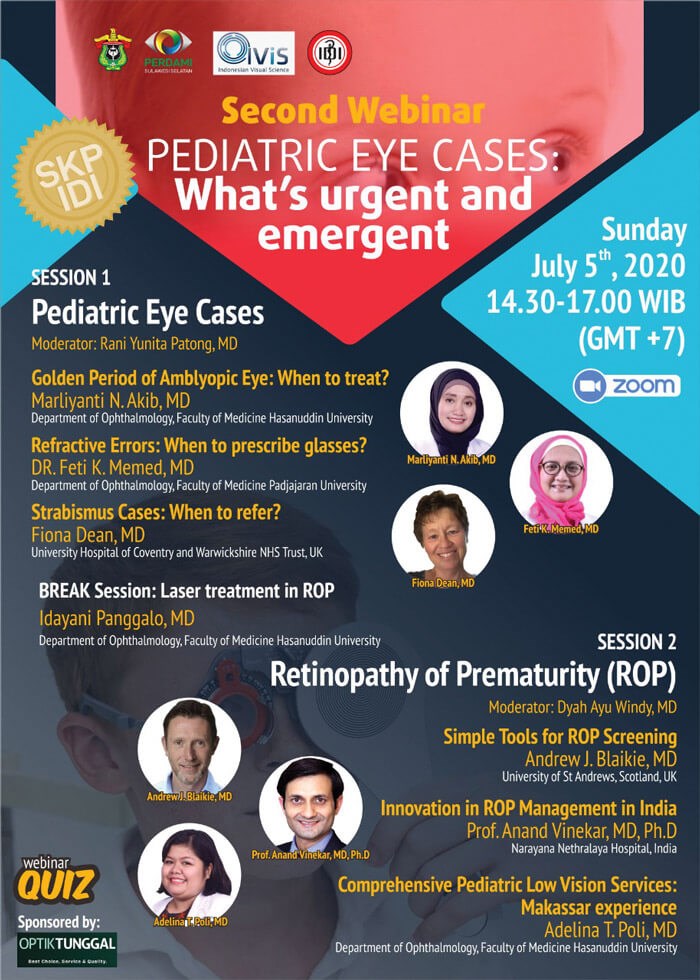
Poster promoting the paediatric eyecare webinar, July 2020.
To follow this up, in 2020 a webinar was led from Makassar, this time by Dr Marlyanti Akib, looking at a variety of paediatric conditions, primarily ROP. The Indonesia Multicenter Study of ROP (IMSROP) [7] was presented. Data suggested a downturn in the prevalence of ROP due to better control of oxygen usage compared with earlier years. The study reported 12,115 eligible infants born at ≤34 weeks. Mortality was 24% and any stage ROP was reported in 6.7% of infants screened.
These workshops have further reinforced the professional and educational links between Makassar and Dundee. We plan to jointly deliver future workshops, albeit for the moment remotely.
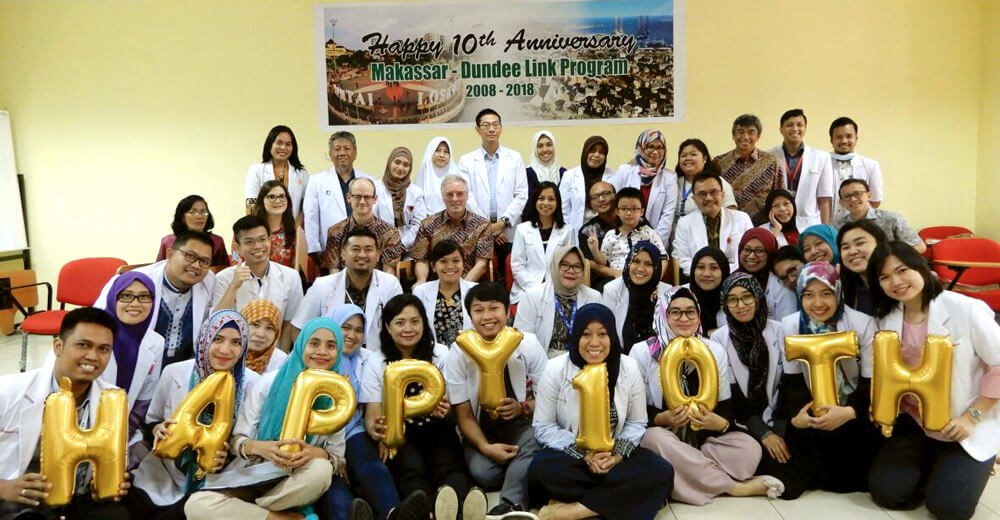
The 10th anniversary of the Makassar-Dundee LINK in 2018.
The future – lessons learnt, what next?
LINK visits continued once or twice a year, both to Dundee and Makassar, between 2014 and 2019, including the 10-year ‘wedding anniversary’ celebration in 2018. The training programme in Makassar grew in maturity. Pass rates at the National Board exams, analogous to the RCOphth Fellowship exams, were maintained at 100%. On three occasions Makassar residents took first place in the exam, competing alongside all the other training centres nationally. Dr Ichsan, head of the resident programme, was chosen to join the Asia-Pacific Vitreo-retinal Society (APVRS) leadership programme as the Indonesian representative, under the direct mentorship of Professor Denis Lam in Hong Kong and Koh-Hei Sonoda in Fukuoka University, Japan. Dr Yunita was selected on the 2020-2021 Academy of Asia-Pacific Professors of Ophthalmology Academic Development Mentorship Scheme (ADMS), with Professor Robyn Guymer from Melbourne as mentor.
All these stories and achievements began with mutual trust and the shared vision of better eyecare services in both countries, always seeking one thing: to improve the quality of human resources. And even a global pandemic has not been able to stop this progression.
References
1. Ellis J, Muhiddin H, Zondervan M. The invisible touch: a VISION 2020 LINK with Indonesia. Eye News 2014;20(5):24-8.
2. Zondervan M, Msukwa G, Onyango J, et al. VISION 2020 LINKS Programme: the contribution of health partnerships to reduction in blindness worldwide. Eye News 2020;26(6):7-12.
3. Geneva Foundation for Medical Education and Research. Menopause - Country-specific information of Indonesia:
https://www.gfmer.ch/Books/
bookmp/173.htm
4. Indonesian Ministry of Health:
https://covid19.go.id
5. University of St Andrews. Arclight Project:
http://med.st-andrews.ac.uk/arclight/
6. University of St Andrews. SIMulation Eye:
http://med.st-andrews.ac.uk/
arclight/teaching-materials/sim-tools/
7. Siswanto JE, Bos AF, Dijk PH, et al. Multicentre survey of retinopathy of prematurity in Indonesia. BMJ Paediatrics Open 2021;5:e000761.
(All links last accessed April 2021)
COMMENTS ARE WELCOME


